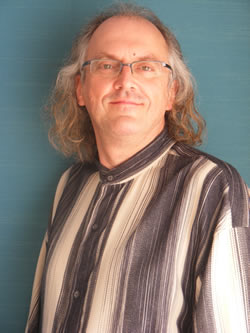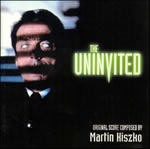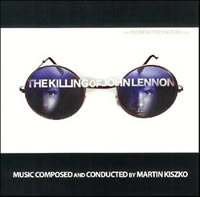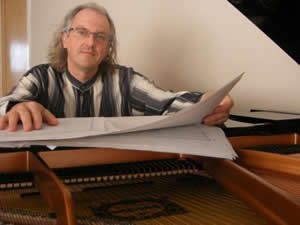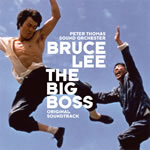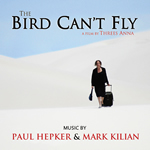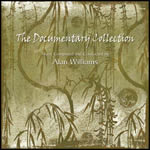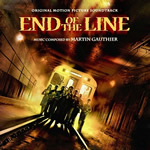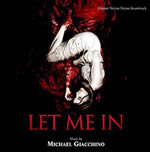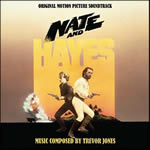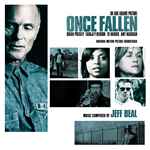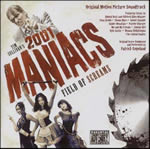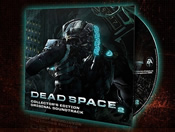
 |
Soundtrax: Episode 2010-10
November 29, 2010By Randall D. Larson
Martin Kiszko The Exceptional Film Music of Martin Kiszko
Born in Leeds, UK in 1958, composer Martin Kiszko is of Polish-British origin. Between 1984-1997, Kiszko composed and orchestrated over 200 scores for film and television. Amongst these were the landmark natural history series REALMS OF THE RUSSIAN BEAR (1992) (TV), in which he pioneered the recording of music samples on film locations as well as using ethnomusicological research to assist the natural history score. He subsequently introduced the palette of East European orchestras to BBC Natural History programs such as ALIEN EMPIRE (1996) and BATTLE OF THE SEXES: IN THE ANIMAL WORLD (1999). In addition to composing, recording, and performing a number of concert works, Kiszko has written many well known TV signature tunes for regular BBC news and documentary shows. His score for the BBC’s Dreamworks promo, requested by and made for Steven Spielberg and the BBC, was awarded Best Music Video at Missoula Film Festival, USA. During the early part of 2007, Kiszko composed, conducted and performed the score for the new major movie THE KILLING OF JOHN LENNON (2006), which is available to order via the composer’s web site, www.martinkiszko.com/
Q: Your work for films has been a comparatively small portion of your overall musical endeavors over the last two decades. What led you into composing music for films?Martin Kiszko: I had a Polish father who was passionate about music and a music teacher from St. Kitts who inspired me as a young musician. As a teenager I was always interested in combining music with other media. This is why I took Music and Fine Arts at university followed by a second degree in film. Then a PhD – again in music. I believe the composition of film music is a bilingual craft. The composer must be as intimate with the language of film as s/he is with the language of music. And so this was the catalyst for working in music for film. But it was as a result of my mentor – veteran British film composer Edward Williams (who had worked with Vaughan Williams and Muir Matheson) that the floodgates into film music were truly opened. I joined Edward on Sir David Attenborough’s LIFE ON EARTH. Edward was a completely intuitive, ‘bilingual’ film composer with a phenomenal grasp of orchestration – and I so wanted to follow in his footsteps. He generously helped me find the path. I was also indebted to other well know film composers who championed me – namely Wilfred Josephs and Sidney Sager.
Q: Your first film score was for the Channel Four series, ZASTROZZI. How did you find this first experience – what kind of music was needed and what was most challenging for you about this assignment?
Martin Kiszko: ZASTROZZI – A ROMANCE was an astonishing surreal adaptation of Percy Bysshe Shelley’s gothic novel. The drama series was written and directed by maverick Brit director David Hopkins and starred Tilda Swinton and the legendary comedian Max Wall. As my first major drama requiring 90 minutes of chamber orchestral score, the challenge was daunting. Especially so as the director and I had decided that most of the score would be written to the story or script. This was because David intended to use the completed score as the guide for choreographed camera moves, tracks and pans on location - I guess very much in the same way as Leone and Morricone worked on ONCE UPON A TIME IN THE WEST – one of my favorite movies. What is so challenging about working to story or script is that the composer must get the score correct at the outset without all the other departments – lighting, camera, production design, sound – feeding the composer’s imagination. This means the composer must be totally in tune with the nuances of the screenwriter’s craft and feel a strong affinity to the emotional, psychological and action-based beats of the narrative.
David also wanted a score that would work operatically with the narrative action and characterization. He got me to write harpsichord recitative to weave around dialogue and wanted waltzes and florid pieces stirred with a twist of the dark and ominous. I used Mozart and Johann Strauss as my templates. It was with this score that I formed a working relationship with conductor Harry Rabinowitz. Harry’s exceptional ear and meticulous attention to detail, alongside the ability to work under considerable pressure, was a tremendous contribution to the realization of the soundtrack.
Q: You’ve shown a persuasive proclivity toward scoring documentaries, from your NATURE episode, LAND OF THE EAGLE and the REALMS OF THE RUSSIAN BEAR to the ALIEN EMPIRE and BATTLE OF THE SEXES series. How have you find the differences between scoring a dramatic fiction versus a nonfiction documentary – are their musical needs dissimilar, or not?
Martin Kiszko: Both documentaries and fiction films are about storytelling – whether those stories are true or imagined. I always scored on the basis of supporting the developing narrative. There were, however, especial arguments to be had in the realm of scoring for natural history films; the old chestnut of whether the music was ‘anthropomorphising’ the creatures, i.e., giving them human facets such as emotion.
I was particularly and, in my mind, unnecessarily and bullishly lambasted by British columnist Lynne Truss in a British newspaper in 1995. My crime? I had written a lush and dramatic 90 minute orchestral score performed by the Munich Symphony Orchestra for a BBC series on insects called ALIEN EMPIRE. The director Steve Nichols had asked for an epic large scale score to represent the fact that these creatures were actually a miniature world of ‘beasts with armor’, ‘sophisticated pieces of hardware’ or ‘extraordinary natural phenomena’ – such as the flight of millions and millions of Monarch butterflies. In his mind (and mine) this required robust and expressive musical forces (rather than a flute and a clarinet!). We also included very romantic strings for one sequence about the mating of two moths. The journalist ridiculed the musical approach – finding it too ‘feature film score based’ for a TV series. Yet ironically, I was ahead of my time and some months ahead of the film scoring world. It wasn’t long before many major natural history documentaries and series were also using large expressive orchestral forces to underscore the natural world. We all know that art leads the way – often on a contrary trajectory to critical response!
Q: How did the musical texture for RUSSIAN BEAR come about and how was it integrated into the score’s musical direction?
Martin Kiszko: REALMS OF THE RUSSIAN BEAR was an extraordinary challenge. I thrive on musical challenges and this one became a mission that eventually led to the award of a PhD for my work on Russian music – specifically the migration of the balalaika from Russia to the USA. My aim with the score was to become the first composer to travel to a natural history film’s location and collect indigenous samples for the score. The BBC agreed to this and I set to work researching around 1700 native instruments of the former Soviet republics. Once these instruments had been reduced to a palette of around a hundred, I presented the timbres of the instruments to the directors who chose about sixty they liked. I then scored stand-alone pieces (as I had done on previous films) before the films had been shot. These cues were recorded with indigenous musicians at the Melodia studios in Moscow. I then recorded, with every instrument of the palette I had chosen, every note on the instrument – played with different durations. I also recorded scale passages, arpeggios, glissandi, melodic motives, rhythmic motives and ornaments (melodic decorations). This meant I could then input that material into my Emulator 3 sampling instrument and compose cues from scratch at the keyboard. Furthermore, I also used the samples to overdub the previously mentioned stand-alone pieces I had composed for ensembles in Moscow. This trail-blazing technique worked successfully and in a sense became a benchmark for the compositional approach on natural history scores in general.
Q: ALIEN EMPIRE was an especially provocative score which at times achieved an almost epic musical sensibility and scope. What were your initial impressions and how did this develop through to the final score?
Martin Kiszko: ALIEN EMPIRE was one of my favorite scores to compose and orchestrate. I used a timbral palette based on Herrmann’s rejected score for Hitchcock’s TORN CURTAIN. Some of the cues have 16 horns, 12 flutes doubling alto flutes, strings, harp and piano. Like some of my previous scores, the director asked for electronic sketches of cues to be written before the material was shot. Once the material was shot and edited, these sketches were laid against picture and then (contrary to normal practice) the picture was adjusted to fit the pace and drama of the music. The technique worked well and was often akin to cutting a music video.
Q: What kind of response have you received from your ALIEN EMPIRE score? Did it bring you any attention or additional scoring offers?
Martin Kiszko: It was the first of my eight albums and though deleted now – it has become a soundtrack collector’s item and I’m still approached by aficionados from around the world who write about how much they love or are moved by the score. The soundtrack was well received by the general public and my peers alike. One of the flattering (but financially disappointing!) aspects was that producers asked other composers to emulate the style of my score. Of more serious concern than that was the posting of information on the internet by a fan of the soundtrack that compositional and stylistic aspects of the score may have been poached for a major Hollywood movie. This was extremely upsetting and too close for comfort. I eventually put the episode down to ‘pure coincidence’ even though I could hear that there were similarities. But I was recently very concerned again when another recent Hollywood blockbuster felt as if its composer (who had my album) was serving up an approach and orchestration again virtually similar to my ALIEN EMPIRE score. While I felt I should have the grace to put it down to the possibility that my album may have been used as temp track – part of me feels that a major opportunity to share my music with the feature film fraternity and an audience has been usurped and lost – perhaps irrevocably affecting my short term sustainability and my long term career. On the other hand, I am a resilient person – never to be beaten – and there is a wealth of original and newly imaginative music left in me – no matter who poaches my reserves! One of my mottoes and favorite quotes by essayist and philosopher Henry David Thoreau is: “When I hear music, I fear no danger. I am invulnerable. I see no foe. I am related to the earliest times, and to the latest.”
I am determined to find the next visionary director that will invite me to share their filmic vision. Hey and if any of you Hollywood composers still have my ALIEN EMPIRE album – send it straight back now!! J
Q: The BBC’s BLACKHEARTS IN BATTERSEA was a period drama, intended for children. What challenges did composing for period present to you – and did the fact it was geared for a younger audience impact your musical approach at all?
Martin Kiszko:BLACK HEARTSwas a great six-part drama series for which to compose. Any film composer must be eclectic in their listening as well as in their ability to pastiche from any genre or period. So writing material that harked back to the mid-nineteenth century wasn’t a problem. Sometimes it’s necessary to research a genre but, in this case, I found it very straight forward. In fact I had three days to compose, demonstrate electronic sketches, arrange and score for chamber ensemble per each thirty minute episode – so there wasn’t a great deal of time to think about it! I composed what intuitively came into my head as I considered the period narrative.
Furthermore composing a soundtrack for children shouldn’t be any different than anything else. Children are very sophisticated listeners and deserve a great score as much as the next person!
Q: THE UNINVITED gave you an opportunity to score a darker subject matter and musically accentuate this fictional exploration of alien abductions. What was your take on scoring scary sci-fi and joining the ranks of the horror film composers?
Martin Kiszko: I wanted a palette, texture, and orchestration that would create a hybrid of the dead and the living – of alien and human. This is why I chose voices, alto flute, oboe d’amore, piano and strings – providing ‘expressive human intonations’ in contrast to the cold rigid minimalist pad of electronics in the score. The two worlds were at times separate in the story line but then – in terms of the alien abduction – they would collide. It was this collision I attempted to work into the underscore. I also kept the score as transparent and simple as possible to stay clear of the important exposition of plot in the action and dialogue of the narrative.
Q: Your score for THE KILLING OF JOHN LENNON was an especially compelling dramatic work. I understand you were called in to replace a score that wasn’t working out. What were your initial instructions for music from the filmmakers and how did your score develop?
Martin Kiszko: Well a few tracks had already been placed that were always going to stay. These were the ones fitting the Hawaii scenes and featuring Hawaiian guitar. All the other tracks were disparate temp tracks with no musical ‘connective tissue.’ They would also have been prohibitively expensive for the film’s budget to clear. So they had to be left behind at the checkout.
I met the producer at Cannes in a bar. We talked about astronomy and cosmology before discussing film and really got on well together. A couple of years down the line he and the director Andrew Piddington showed me the temped up film and asked if I’d like to rescore most of the temp.
The film required a very dark, brooding score but with a simple palette. I was at the precipice of a particularly dark point in my life at exactly the time the score was offered to me. I wondered whether I could take the load on top of what I was going through, but the offer of the score and my life experiences at that time seemed too ‘synchronous’ to reject the job. So dark and brooding is what I delivered – an ambient vacillating electronic based score overdubbed with chamber ensemble: alto flute, oboe, piano, strings, soprano and counter-tenor.
The director had also included sound effects that entered or exited at specific musical pitches. He wanted any incoming or outgoing music cues to match those pitches. So the score took on a technical challenge too. Other challenges included the writing and delivery of a sixty minute score for electronics and chamber ensemble in twenty-one days.
Q: How did the process of replacing (and retaining portions of) a previous score affect your composing something of your own for that film, and how did the subject matter and its historical impact affect what you wrote?
Martin Kiszko: The process of replacing or joining in with extant score didn’t bother me. I liked the musical puzzle it presented and the technical challenge of matching key relationships and considering the balance of my specially composed cues with incoming or outgoing non-original music.
The fact that the film was based in 1980 didn’t affect my approach to the score. My only thought was to include a twist of sampled guitar or piano here and there as a kind of motivic tribute to Lennon – but it was incredibly subtle and the main thrust of the score was to be a simple underscore to a psychological portrait and the tragic outcome that the film sought to portray.
Q: Having looked back at these scores as a portion of what you’re doing, musically, and where do you feel this fits in your musical career as a whole, and where would you like to see the world of film music take you in the future?
Martin Kiszko: I’ve composed about 220 scores for film and TV and have been very proud to work with accomplished filmmakers. I have met and been nurtured by wonderful people on the way including Fred Zinnemann who was a great aficionado of my LAND OF THE EAGLE score. I am proud of all I have accomplished and have relished the challenges filmmakers have thrown at me!
I am best known as a composer of orchestral scores (though my early music background was, in contrast, in electronics!) So, the return to a largely electronic palette with THE KILLING OF JOHN LENNON was a pleasurable return to early roots. The album is a particular joy for me. It benefits by having no photograph of me in the booklet or on the sleeve – and so the listener thus far has thought the composer is between 20 and 25 years old! It is mostly young people that have found the score stimulating and the oldies appear to sit in the bath surrounded with tea lights with the score massaging their innermost psychologies. In a sense, I feel the score has reinvented me as a composer. There is a renaissance.
A seventeen-year-old approached me in a movie theatre recently and asked if I was the composer of the KILLING OF JOHN LENNON score. When I said yes, he said, ‘Oh man that is such a fucking awesome score.’ I returned home immediately to tell my fifteen-year-old son what this young man had said. My son thought it was ‘so cool.’ Finally I had ‘scored’ with my own boy! In the eyes of the young – I was a cool composer! It was then I felt I was on the next step of my journey as a composer.
As a composer who is fully intimate with the craft of the screenplay and the language of music and with a wealth of that inner child still left to fire the imagination – I feel ripe for a future of feature film scores and am ‘only a phone call away.’ Sounds like a title for a Gene Pitney song – but it isn’t.
Martin Kiszko is represented by Jeff Kaufmann at the Kaufmann Agency, Los Angeles. My thanks to both Martin and Jeff for their time and assistance in facilitating this interview, and to Martin Kiszko for his candor and straightforward sharing of his perceptions and experiences in film music. - rdl
For more information on Martin Kizsko, please see: www.martinkiszko.com/
New Soundtracks Releases of Note
THE BIG BOSS/Peter Thomas/All-Score Media & Chris’ Soundtrack Corner
The musical approach to early Shaw Bros. and Golden Harvest kung-fu movies in China was eclectic and inconsistent. Many films borrowed liberally from American and European rock and soundtrack records while, by the 1970s, they began to feature originally composed pop music written by guys such as Joseph Koo and Wang Fu Ling, both of whom scored Bruce Lee’s debut film, THE BIG BOSS (1971; known as FISTS OF FURY in the US) – although the film still swiped a few tracks from Hollywood soundtracks and a whole section of Pink Floyd’s Dark Side of the Moon as a prelude to one of the big gang fights. Overseas, though, just as Hollywood frequently replaced the music from European movies to something they felt would be more palatable to American audiences, European studios did the same for Hong Kong movies. Thus, when THE BIG BOSS debuted in Germany in 1973 as BRUCE LEE – DIE TODESFAUST DES CHENG LI it was accompanied by a brand new score composed by Peter Thomas and performed by his orchestra. Thomas was well known in Germany for composing the exciting rock/pop/jazz music for the Jerry Cotton series of spy movies and various crime films based on Edgar Wallace novels; he was far better known at the time than Bruce Lee was and thus is was felt replacing the original score with toe-tapping music from the admired Peter Thomas Orchester would benefit the movie’s profits in West Germany. While the original Koo/Fu Ling score has been released on a bootleg-quality CD as part of a “Bruce Lee Collection” soundtrack series in the US, only a few tracks of Thomas’ score have been included on various collections of Thomas’ music. To the rescue comes All-Score and Chris’ Soundtrack corner with this splendid 20-track release containing all of the music written and performed by Thomas and his orchestra for the score. The music – brass-driven rhythm section pop and post-modern big band jazz – is sumptuous, vigorously performed. Peter Thomas had a knack for wrapping his own brand of jazzy pop around virtually any type of film, whether it was a period horror story, a contemporary krimi crime film, or a 007-esque spy movie, and he gave THE BIG BOSS the same kind of swinging vibe. Built around a brassy main theme, the music occasionally assumes a vague Oriental flavor through its melody line or instrumentation (the chiming cadence of “Blood and Dead Friends,” for example), but mostly it’s hard driving, American-styled rhythm section music that will definitely please listeners.
See: www.soundtrackcorner.de
THE BIRD CAN’T FLY/Mark Kilian and Paul Hepker/Lakeshore
Composers Mark Kilian and Paul Hepker rejoin to compose an inventive score for THE BIRD CAN’T FLY, a 2007 drama of a dysfunctional family restored, starring Barbara Hershey. Kilian and Hepker, both accomplished composers on their own, previously worked together for director Gavin Hood’s RENDITION (2007)and TSOTSI (2005; winner of the Best Foreign Film Oscar) – see my interview with them in my column for 11/5/07. The musical score for THE BIRD CAN’T FLY combines the same kind of spacious exploration of world music instruments and memorable themes that has typified their previous collaborations, made up of a festive and familiar aural backdrop of flutes, voices, airy ascending percussive rhythms contrasted against the downward descent of slide guitars, all of which “lends an evocative and unsettled ambience that occasionally breaks out into bursts of hi-octane percussive muscle,” as CineMedia’s press release aptly described the music. It’s a thickly layered acoustic composition that rings with familiar flavors and evocative textures, echoing the wistful pain of awkward family moments, the grief of loss, the hesitancy of reaching out, the fulfilling joy of harmony. There are hints of the African ethnicity with which the composers laced both of their previous collaborative scores, but the majority of the music is both timeless and placeless – evoking in its rhythmic acoustics a sense of shared histories and communal gatherings. This is a tone poem for family – in its brightest and darkest moments, and the music even apart from the film carries a very pleasing air. The soundtrack includes a couple of songs written specifically for the film, as well as a New Orleans-style funeral march featuring the voice of Inara George.
THE DOCUMENTARY COLLECTION/Alan Williams/Silverscreen Music
While he’s scored all manner of films and television, Allan Williams has become particularly noted for his music for documentary films and television over the last thirteen years. This new double-CD compilation from his own label compiles 53 tracks of his best documentary music into one marvelous sampler. Williams has divided the documentaries into geographical films (AMAZON, KILIMANJARO: THE ROOF OF AFRICA, MARK TWAIN’S AMERICA, ICELAND VOLCANIC ERUPTION, etc.) on Disc 1, while the second disc features music from historical (GETTYSBURG: THE SPEECH THAT SAVED AMERICA, IN SEARCH OF LEWIS AND CLARK) and wildlife films (ISLAND OF THE SHARKS, FREEDOM OF THE SEAS, etc). Embracing a thematic approach to documentary scoring, Williams’ gifts for melody, rhythm, and instrumental textures are very much in evidence in these documentary scores, which focus on environment and situation, evoking their expressive drama from significant moments of history, the grandeur of the natural world, and the joy, and grace, and struggles of wildlife on many lands. The diversity of these documentary films and their locales and subject matter affords a great variety of musical styles, such as the joyful African chants of “Kilimanjaro,” the poignant violin soloing of “Japanese Sunset,” the powerful mix of large hand drums, female voice, and electric solo guitar in “Glaciers,” the piercing Middle Eastern singing of “The Dead Sea,” the poignant Americana of “Lincoln’s Legacy,” the reedy hollowness of ancient woodwinds and mighty drums on “Land of Vikings,” or the contrast between the quickly chanted singers and the slowly expanding melody line of the orchestra in “Journey’s End.” That’s a sense of epic grandeur in almost all of these scores, reflecting as they do the astonishing characteristics of the natural world. While Williams’ adopts ethnic traditions associated with locale in these documentary scores, there is nothing traditional about the music he evokes to enhance them. Williams’ melodies often assume the kind of gracefulness often associated with John Barry or Jerry Goldsmith. When the melody opens up out of the plaintive flutes of “The Rainforest,” for example, the music provides a stunning musical epiphany that is extremely moving. Likewise the gentle string line in “Rift Valley” when it expands to reflect with full orchestra the vast grandeur spread out before the camera. This is fine film music, plain and simple, and its collection on these two discs accommodates a fine listening experience as well as a splendid gallery of Williams’ music in this realm.For more information on this and other soundtracks, see: www.alanwilliams.com
END OF THE LINE/Martin Gauthier/2M1 Records
This percussive horror score intensifies the progressive grip of the story, which tells of a commuter subway that unaccountably stops in the middle of the tunnel. As something begins brutally murdering the passengers, a handful of survivors must face supernatural forces, homicidal religious cult members, as well as their own fears and suspicions of Armageddon, in order to survive. The Canadian film was the official selection of the 2006 Toronto International Film Festival and was the Winner of the Audience Award for best feature at the Scotland 2007 Dead By Dawn Film Festival. Gauthier’s musical score is a potent scare score constructed of familiar elements that works quite well at capturing an uneasy tonality and driving it home into pure sonic terror. It’s straightforward and chilling, mixing sampled orchestral elements with creepy electronics to give the film its visceral sonic edge, built out of both a melodic thematic structure and a hybrid atmospheric grain. Opening with a powerful undulating main theme that provides both a sense of speed and destiny as the characters are carried off into their fate in the subway tunnels, Gauthier represents the heroine Karen with a soft and resolute piano melody backed by soft choir. These two themes pair off to reorient the story around the character and the propulsive situation – and consequently the desire to endure the battle and survive their journey through the darkness; the two motifs combine effectively in “Armed and Dangerous.” Around them lay a series of arduous suspense and horror motifs and set-pieces comprised of textural interaction, percussive synth pads and reflective tonal surfaces, music which is scary in itself and thereby intensifies the characters’ interactions with the forces of evil. The use of choir supports that metaphysical elements and the notion of religious Armageddon while also strengthening the characters’ resolve in a moral battle against demonic principalities. “Sarah’s Faith” demonstrates the film’s spiritual battle clearly in its use of chanting choir and (what sounds to be) Latin phraseology. Overall it’s a very dark score, but it’s sonically interesting and effectively resolved around its musical elements of humanity, faith, goodness facing off against the shadowy things that lurk in the darkness.Further ferocious film scores coming up from 2M1 include the horror films FROZEN and both HATCHET and HATCHET 2 (all three films featuring music by Andy Garfield), due out in mid-December.
See: www.2m1records.com
LET ME IN/Michael Giacchino/Varese Sarabande
Michael Giacchino has provided a compelling and potent orchestral composition for this Americanization of the acclaimed Swedish vampire movie, LET THE RIGHT ONE IN (2008). I haven’t had a chance to see the film yet but the score is a purposefully rendered journey into darkness, carrying the listener out of it, perhaps a little blood soaked, but grateful for the experience. For his first real horror score, Giacchino has maintained a classically styled orchestral tonality, avoiding the kind of electronic hybrid sound-design that has become popular in horror films of late. Keying in on equal measures of sentimentality and very dark brooding tonal atmospheres, Giacchino has wrapped the score in an environment of verisimilitude that focuses on character - both that of the young girl vampire and of the young, shy boy who befriends her. A subtle use of voice lends a haunting spirit to the vampiric elements of the young girl, even while sustaining a strong sympathy in her direction, and interlaces with the music of the young man as the two of them become closer. Giacchino’s main motif is introduced in “Los Alamos,” mirroring the slow, reverberated drum pounds that open the track with similarly dour intonations of descending low brass; a moan-like chorus of repeated horn blares, like staked being pounded into dead flesh, that immediately crafts a mood of irresolute darkness into which, as it increases in volume and intensity and sonic nearness, carries the listener into its shadowy confines, piping woodwinds flitting about on leathery wings as the pounding brass chords reach their fulfillment. A number of tracks provide variations on this slow, staccato drum-and-brass chord progression, which creates a creepy and somewhat claustrophobic mood. It’s almost an antithesis of the tried-and-true rapid-footsteps music of monster scores of yesteryear, where punchy brass chords mimicked the advancing footsteps of Amazing Colossal Men and Giant Behemoths; but here it’s whisper-slow, the slow movement of shadows across stone, the languid advance of sweat trickling down the back of one’s spinal groove; the measure of a heart beat running far too slow.Non-melodic strains of low-end piano, carefully plucked harp, and close-miked tremolo strings build a very tangible tension out of this motif in “The Back Seat Killer,” which develops into an undulating, progressively intensifying demarcation of imminently closing peril. “The Asphalt Jungle Jim,” where Owen and Abby meet, introduces a similarly percussive motif, for piano and harp over soft tremolo strings, adopting the same type of stabbing interaction as in the horror motif only here it is conveyed with gentle measures, airy tones, and a gentle poignancy that is very much contrapuntal to the very ominous dark music heard elsewhere. But, like Owen and Abby themselves, the music remains furtive, withdrawn, hesitant to develop into a true melody; even the intrusion of a boy soprano into the orchestration wafts lonely and melancholic above the rhythmic undulations of violins; only in moments does their growing friendship flower, as in the brief measure of brightness in “At Your Disposal,” which endures a dark crescendo to reach a confident understanding through a cluster of piping winds and a warm note from strings and semblances of intimacy harbored in “Neighbors of Love,” “First Date Jitters,” and especially in the glad marcato strokings and pipings of “New Day On An Old Lake.” These two primary patterns develop throughout the score as the story plays out, embellished by some dark and scary moments such as the strident violin figures of “Let Me Out” and the chorus-laded chords that herald the attacking clusters of squeaking strings and winds of “Virginia Territory.” One of the score’s spookiest moments is found in “Acid Test Dummy” in which a propulsive array of sliding strings, horn blares, growing insectile violin figures, and an onrushing assemblage of chorus and orchestra undulate into a quickening pattern of relentless presence that is very frightening. The score ends with the resolute and pretty soliloquy of “Trained and Steady” – a piece that was originally composed much like the warm melodic portion of “At Your Disposal,” full of confidence and a steady, bouncing marcato rhythm but which was replaced by the more reserved closing track that now closes the film (Varese Sarabande has kindly included the original version of the track on the album). The score, therefore, closes rather like it opens, with a sense of quiet, fatalistic melancholy – but with a continuance all the same. Giacchino leaves it up to his End Title track to enliven the album with a pleasing and joyful denouement.
In many ways LET ME IN is a minimalistic score, deriving its powerful personality from very slow and mostly understated characteristics of percussive sound, punctuated by a variety of advancing patterns that provide crescendos in the misty atmosphere of the score. But it’s potency lies in its demure progression, like the shy, dropping gaze of an ashen-faced girl whose eyes suddenly snap to focus… right into your own.
NATE AND HAYES/Trevor Jones/La-La Land Records
Earlier this year, La-La Land Records and producer Dan Goldwasser released the premiere recording of Trevor Jones swashbuckling adventure score for NATE AND HAYES, a 1983 period adventure film in the spirit of RAIDERS OF THE LOST ARK, and also known as SAVAGE ISLANDS. It starred Tommy lee Jones as real-life pirate William Henry “Bully” Hayes and his association with the Reverend Nathaniel (“Nate”) Williamson to rescue Nate’s bride-to-be from brigands even less scrupulous than Hayes. Jones’ music is a wonder of melodic adventurism, built around an engaging main theme that crops up frequently to bolster battle music and serve as a thematic banner for the exploits of the titular triumphant heroes. A lilting love theme is also provided for Nate and his intended, which becomes especially poignant during her absence when abducted by the brigands, echoing Nate’s yearning to find her while also supporting a live triangle as she instead becomes interested in Hayes. The score is a great example of thematic interplay as both themes weave throughout the music as story and score play out; it’s one of the great adventure scores of the 1980s and it’s grand to have it available in such fine form after so long. The album includes thorough commentary and track-by-track notes by Jeff Bond, and contains music not used in the film, all of which is very splendid.
ONCE FALLEN/Jeff Beal/MovieScore Media
Emmy Award-winning composer Jeff Beal takes a walk into Mark Isham/CRASH territory with his evocative score for ONCE FALLEN, an urban crime thriller about a corrupt cop, starring Ed Harris and Amy Madigan. Beal creates an effective, frenetic contemporary urban vibe favoring a pallet of acoustic and electric guitars, piano, drums and other percussion, creating a pleasing riff suggestive of life in motion. While a jazzy, noirish trumpet evokes the lonelier side of the city and the isolation of the city’s finest, the primary thrust of the music is in evoking isolated pockets of activity, constantly moving, interacting. Even the lonely trumpet motif is backed by particles of sonic movement. The score retains this sensibility throughout, slightly aloof, cold and irresolute like the urban landscape in which the characters trod.
SKYLINE/Matthew Margeson/Varese Sarabande
In the first of a couple of Aliens-Invade-Los Angeles movies emerging from Hollywood (the other is BATTLE: LOS ANGELES coming out next March; Brian Tyler is scoring it) SKYLINE hasn’t fared very well. It’s musical score, however, is worth some consideration. Composed by relative newcomer Matthew Margeson, a member of Hans Zimmer’s Remote Control team who has been orchestrating and generating “additional music” composer and arranger credits for a few years now, the score is a likably large scale orchestral disaster movie score. Margeson’s fourth feature film score since last year (the other three were all comedies) and surely his break-out score as a credible solo composer, SKYLINE does show the inevitable fingerprints of a composer/arranger apprenticed in the Zimmer tradition (the marcato strings of “Don’t Look Up” and “They’re Not Dead”, the epic lament of the “Abduction Theme,” â la Harald Kloser and Steve Jablonsky ) but it’s a workable large form hybrid score of orchestra, synths, and choir that gives the film a valid measure of size and scope, and works very well on disc by itself. It captures an appropriate level of cosmic menace in its dark, sweeping melodies and percussive propulsions, while tracks like “Skyline” provide suitably dark measures that seethe with an alien vitality all on their own. Whereas previous iconic alien invasion movies like INDEPENDENCE DAY, BATTLEFIELD EARTH, and TRANSFORMERS tended to focus on the heroes in their scores, Margeson takes the time to compose some peculiar tonalities that delineate a very alien-structured sound design (“Skyline,” “Arrival”), enveloping the invasion not so much in broad strokes of chaos for Planet Earth, but by focusing on capturing a sense of alien presence in the tonality and texture of the accompanying music. The aliens invade not with bombast but with a seething, unearthly character that makes their infestation far creepier; when it’s joined by the “Abduction” theme (at the end of “Arrival”) it captures both a sonic sensibility of the infiltrating alien presence but the humanistic suffering that is left in its wake; or when it’s joined by a bold and brassy theme of confident counterattack (“Make A Run For It”) it expresses a significant contrast between the two, aggressor and defender. There’s still plenty of the bombastic to be had (the second half of “The Resurrection” and all of “Final Battle” are powerfully arranged and massively powered battle cues), and the album closes with a rock instrumental written by Margeson and performed by the band Madsonik.
2001 MANIACS: FIELD OF SCREAMS/Patrick Copeland/BSX Records
The music for Tim Sullivan’s haphazard sequel to his riotously over-the-top exploitation terror tale, 2001 MANIACS, a 2005 remake of the celebrated 1964 funfest from godfather of gore Herschel Gordon Lewis, runs the gamut from actor-performed folk singing, heavy southern rock and psychobilly tunes from bands like Psycho Charger and Zombie Girl. It also contains straightforward orchestral underscore from Patrick Copeland, a composer who worked with Sullivan previously on the anthology horror movie, HOOD OF HORROR (and who is now scoring an anthology horror musical co-exec-produced by Sullivan called CHILLERAMA). BSX, which released the album in a limited run of 1000 units,, has included all of the above on the 50-track album, including a few snippets of the film’s wild dialog from Bill Moseley, who plays the patriarch of a town full of maniacal, cannibalistic southern ghosts seeking vengeance against the northerners for pillaging the town and its folk back during the Civil War. As with H G Lewis before him, Sullivan’s remakes are over-the-top jokes, reveling in their extreme bloody violence and ample loss of extremities. It’s the songs that make the film work as a whacky comedy as blood splatters and skin flays. But it’s Copeland’s underscore that sets up the grisly jokes, which, for a moment anyway, makes the victimized characters a bit more real and, if briefly, makes the carnage set upon them less funny, allowing the film’s exaggerated humor to make the most of its brutal irony. The songs are clear evidence of this manic sensibility. The score tracks, nicely collected together in tracks 39-49 (44 mins.), are a distinct from the raucous and riotous song and dialog tracks, which serve to amp up the film’s over the top comedy and celebration of gore and grue with a sense of reality. The score works more subtly and far less noticeably to bolster the film’s creepier moments and give its more anticipatory moments – which almost always end with an incredibly gory punch line of violence dismemberment – a potent sense of apprehension. Copeland sets up the jokes with straightforward scoring techniques – and allows the frenzified mania of the cast and the ferocious folksiness of the songs take the punch line home. Copeland also gives the maniacs (all 2001 of them) a kind of homespun charm that contrasts with their vengeful intents. “Showdown” riffs on Morricone to provide a brief Spaghetti Western moment, while the acoustic guitars of “Brokeback” suggests a showdown of a different kind. “The Gutting” is a comical workaday cue for winds and strings, playing this grisly side-splitting sequence entirely tongue-in-cheek; “The Final Reckoning” concludes the traveling troupe’s terrors with a progressive mix of cartoonlike shifts in tone as it follows the maniacs’ final reckoning; again, Copeland plays it straight and concludes the score with a bit of Southern charm from and a tip of the hat and a twinkle of the flute from the Southern gentlemen that just almost covers up the sound of the dripping blood.Soundtrack & Music News
A new web site has been launched in honor of British composer Barry Gray, whose music for Gerry Anderson’s series of “Supermarionation” shows like THUNDERBIRDS and SUPERCAR were renowned for their modern, provocative vibe. See: www.barrygray.co.uk/BG/Home.html
Intrada Records’ latest limited edition release is the world premiere of Terry Plumeri’s original soundtrack to BLACK SEA RAID (aka SPECIAL FORCES), a 1997 action film about an intense rescue operation by special forces team inside Russia, with conflicts on land, sea, air. Film (also known as SPECIAL FORCES) inspired Plumeri to create an exciting orchestral score with a strong degree of weight and energy. The Full resources of the Russian State Symphony Orchestrate perform the score with stalwart precision. The album, limited to 1000 copies, is presented from digital master elements recorded in Moscow, conducted by the composer. Intrada has also released a 2-CD complete score edition of Jerry Goldsmith’s FIRST BLOOD, containing both the previous album version and the complete film version of the score.
Following on from the success of Doctor Who - Series 4 - The Specials (reviewed in my Nov. 15th column), Silva Screen has released a 63-track, 2CD set of Murray Gold’s music from Doctor Who - Series 5. Steven Moffat’s new vision of Doctor Who, with Matt Smith as the eleventh Doctor, is well matched by Murray Gold’s score. The double album features music from all 13 episodes of Series 5 and includes the new arrangement of the classic Doctor Who theme as well as a number of new themes for the Doctor and his assistant Amy Pond. www.silvascreenmusic.com
Kronos Records will issue The Music From The Films Of Konstantin Ferstl featuring two emotionally charged scores by rising German composer Christoph Zirngibl. The CD, limited to 500 copies, presents scores for two films by director Konstantin Ferstl, LETHE and TAGE WIE JAHRE (Days Like Years). Sound samples can be heard on http://www.kronosrecords.com/catalogue.html
www.moviescoremedia.com
Continuing a relationship with Swedish composer Johan Söderqvist (LET THE RIGHT ONE IN), MSM has released his new score for the critically acclaimed drama IN A BETTER WORLD. MSM reports that this is Johan's eighth film together with Danish auteur Susanne Bier, and while the music certainly has the same touch of intimacy and emotional depth as the previous Bier/Söderqvist collaborations (such as BROTHER andAFTER THE WEDDING), IN A BETTER WORLDis also highly original in its use of instrumental colors. “Carrying the tone in the score is the African instrument Mbira as well as some heartbreakingly beautiful vocal solos – everything elegantly swept in Söderqvist's very personal mix of warm string writing and shimmering electronics,” writes MSM’s Mikael Carlsson.Games Music News
Classically trained BAFTA-winning composer Jason Graves has created a psychodramatic orchestral score for Dead Space 2, the highly anticipated next installment in the blockbuster action horror videogame franchise. Reflecting hero Isaac Clarke’s dementia and nightmarish personal journey, Graves’ original music score for Dead Space 2 features the intricately woven thematic movement “Lacrimosa,” a concerto for string quartet that runs throughout the game. The game’s intense and varied soundtrack also immerses players in this thrilling action horror experience with haunting Unitology choral compositions, visceral action music and spine-tingling string arrangements performed by A-List musicians at Skywalker Sound. “The score really runs the gamut as you play through the game,” said Graves. “There are much bigger and scarier pieces along with quieter, more personal moments to counterbalance them. I wrote for string quartet to portray Isaac’s vulnerable side. It’s quite the emotional arc, but of course still done in a very ‘Dead Space’ way.”
More information on the composer can be found at www.jasongraves.com.
Randall D. Larson was for many years senior editor for Soundtrack Magazine, publisher of CinemaScore: The Film Music Journal, and a film music columnist for Cinefantastique magazine. A specialist on horror film music, he is the author of Musique Fantastique: A Survey of Film Music in the Fantastic Cinema and Music From the House of Hammer. He now writes for CinefantastiqueOnline and has written liner notes for more than 70 soundtrack CDs for such labels as La-La Land, Percepto, Perseverance, Harkit, and BSX Records. For more information, see: www.myspace.com/larsonrdl
Randall can be contacted at soundtraxrdl@gmail.com
